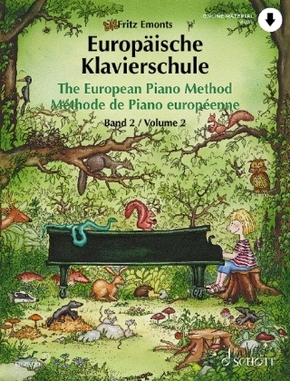| Verlag | Schott Music |
| Auflage | 2021 |
| Seiten | 96 |
| Format | 23,1 x 0,6 x 30,5 cm |
| Noten mit Online-Material (Broschur) | |
| Gewicht | 375 g |
| Reihe | Europäische Klavierschule Band 2 |
| ISBN-10 | 3795724236 |
| ISBN-13 | 9783795724238 |
| Bestell-Nr | 79572423A |
Die Europäische Klavierschule in 3 Sprachen (engl./dt./frz.) mit 7 Pluspunkten: - Spielerischer Anfang ohne Noten - Lieder aus vielen europäischen Ländern - Improvisation und Spiel mit schwarzen Tasten - Ausbildung von Gehör und innerer Klangvorstellung - Systematische, leicht nachvollziehbare Methode - Viele vierhändige Klavierstücke - Attraktive Illustrationen im VierfarbdruckSchwierigkeitsgrad: 2
Inhaltsverzeichnis:
Phrasierung und Artikulation - Die Dur-Tonleiter - Tonleiter-Training - Die Moll-Tonleiter - Wir lernen verschiedene Tonarten kennen - Geläufigkeit und Gleichmäßigkeit - Pedal - Cantabile - Anhang: Begleiten von Liedern und Tänzen - 5 Tänze mit Bordun-Begleitung - Die Kadenz - Liedbegleitung mit 2 Akkorden - Liedbegleitung mit 3 Akkorden - Tänze mit Kadenzharmonik
Following the very successful piano method published in two volumes between 1958 and 1962, the three-volume "European Piano Method" represents a new textbook which takes into account the development of modern piano pedagogy.7 Winning Features of the Emonts Method:1 Songs from many European countries2 Pupils begin to play without music notation3 Improvisation and playing on the black keys4 Development of listening skills and aural awareness5 Simple and logical learning structure6 Lots of duets7 Attractive full-colour illustrationsVolume 2While the first volume of "The European Piano Method" introduces the basic principles of playing the piano, Volume 2 is concerned with extending technical and musical training. The course begins with the theme of 'Phrasing and Articulation'. This is followed by a series of pieces arranged systematically to give practice of playing in different keys (3 sharps to 3 flats) and so to improve reading skills and increase familiarity with the keyboard. To gether with major and minor scales, the corresponding cadences are introduced which can be varied in many different playing styles. Parallel to this there is granded practice material for playing scales and to develop 'Velocity and Even Playing'. In this way students gradually reach a technical standart that allows 'artistic' work on expression and musical interpretation to begin. This development of musicianship starts with the use of pedal and an introduction to cantabile, which will be taken further in Volume 3.Again, playing by ear, inventing accompaniements, experimenting with timbres and chords, and composing little pieces should constantly supplement lessons. In the appendix of Volume 2, the author offers some idea, though he has consciously left much to the individual approach of the teacher.Instrumentation:piano
Inhaltsverzeichnis:
Preface - Phrasing and Articulation - The Major Scale - Scale Training - the Minor Scale - Travelling through Various Keys (3#-3b) - Velocity and Even Playing I - Pedal - Cantabile - Velocity and Even Playing II - Appendices - Accompanying Songs and Dances - 5 Dances with Drone Accompaniment - The Cadence - Song Accompaniment with 2 Chords - Song Accompaniment with 3 Chords - Dances with Cadential Harmony

